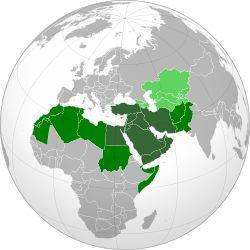Greater Middle East (original) (raw)
From Wikipedia, the free encyclopedia
Loose political term introduced in the 2000s
Greater Middle East
The Greater Middle East is a geopolitical term introduced in March 2004 in a paper published by the Carnegie Endowment for International Peace as part of the United States' preparatory work for the Group of Eight summit of June 2004. The paper presented a proposal for sweeping change in the way the West deals with the Middle East and North Africa.[2][3] It also denotes a vaguely defined region encompassing the Arab world, along with Afghanistan, Pakistan, Iran, Turkey, Israel, Cyprus, and sometimes the Caucasus and Central Asia.[4][5][6]
Adam Garfinkle of the Foreign Policy Research Institute defined the Greater Middle East as the MENA region together with the Caucasus and Central Asia.[4]
The future of the Greater Middle East has sometimes been referred to as the "new Middle East", first so by US Secretary of State Condoleezza Rice, who presented the second-term Bush administration's vision for the region's future in June 2006 in Dubai. Rice said it would be achieved through "constructive chaos", a phrase she repeated a few weeks later during a joint press conference with Israeli prime minister Ehud Olmert when the 2006 Lebanon War had broken out; the meaning of this phrase and the Bush administration's vision have been much debated since.[7][8][9] The efforts to achieve this new Middle East are sometimes called "The Great Middle East Project".[10][11]
Former US National Security Advisor Zbigniew Brzezinski stated that a "political awakening" is taking place in this region which may be an indicator of the multipolar world that is now developing. He alluded to the Greater Middle East as the "Global Balkans", and as a control lever on an area he refers to as Eurasia.[12][_page needed_] According to Andrew Bacevich's 2016 book America's War for the Greater Middle East, this region is the theater for a series of conflicts dating back to 1980, which heralded the start of the Iran–Iraq War.[_citation needed_]
- Middle East and North Africa (MENA)
- Caucasus
- Central Asia
- Arab world
- Muslim world
- Indo-Mediterranean
- Great Game
- Sykes–Picot Agreement
- ^ "World City Populations 2022". worldpopulationreview.com. Archived from the original on 20 February 2020. Retrieved 8 July 2022.
- ^ Perthes, V., 2004, America's "Greater Middle East" and Europe: Key Issues for Dialogue Archived 15 November 2008 at the Wayback Machine, Middle East Policy, Volume XI, No.3, Pages 85–97.
- ^ Ottaway, Marina & Carothers, Thomas (29 March 2004), The Greater Middle East Initiative: Off to a False Start Archived 8 July 2018 at the Wayback Machine, Policy Brief, Carnegie Endowment for International Peace, 29, Pages 1–7
- ^ a b Garfinkle, Adam (1 December 1999). "The Greater Middle East 2025". Foreign Policy Research Institute. Archived from the original on 7 April 2022. Retrieved 22 January 2021.
- ^ "The Greater Middle East Initiative". Al Jazeera. Archived from the original on 7 April 2022. Retrieved 31 May 2021.
- ^ Stewart, Dona J. (2005). "The Greater Middle East and Reform in the Bush Administration's Ideological Imagination". Geographical Review. 95 (3): 400–424. Bibcode:2005GeoRv..95..400S. doi:10.1111/j.1931-0846.2005.tb00373.x. ISSN 0016-7428. JSTOR 30034245.
- ^ Kamal, Baher (14 December 2015). "Silence, Please! A New Middle East Is in the Making". Inter Press Service. Archived from the original on 30 August 2019. Retrieved 30 August 2019.
- ^ Yadgar, Yaacov (July 2016). "A Myth of Peace: 'The Vision of the New Middle East' and Its Transformations in the Israeli Political and Public Spheres". Journal of Peace Research. 43 (3): 297–312. doi:10.1177/0022343306063933. S2CID 144802783.
- ^ Jumana Al Tamimi (10 August 2013). "The 'New Middle East' and its 'constructive chaos'". Gulf News. Archived from the original on 13 February 2021. Retrieved 20 January 2021.
- ^ ""Great Middle East Project" Conference by Prof. Dr. Mahir Kaynak and Ast.Prof. Dr. Emin Gürses in SAU". Archived from the original on 22 January 2018. Retrieved 3 October 2009.
- ^ "Turkish Emek Political Parties". Archived from the original on 2 May 2014. Retrieved 3 October 2009.
- ^ Zbigniew Brzezinski, "The Grand Chessboard: American Primacy and Its Geo-strategic Imperatives" Cited in (Nazemroaya, 2006).















































